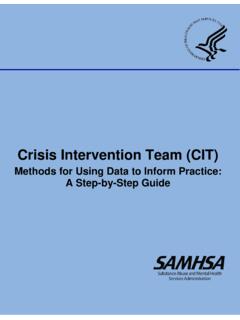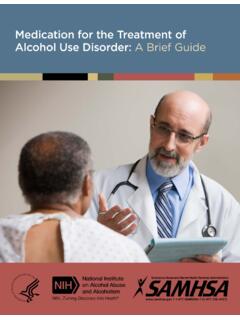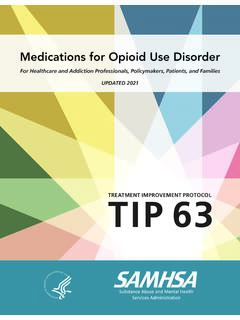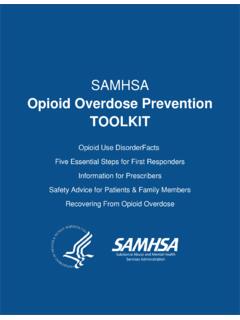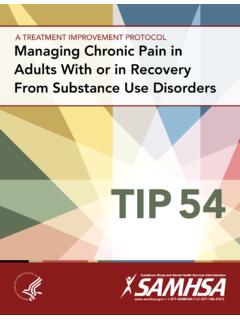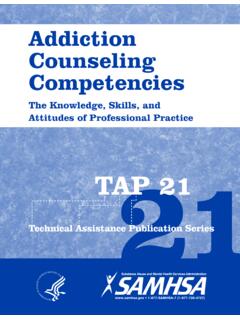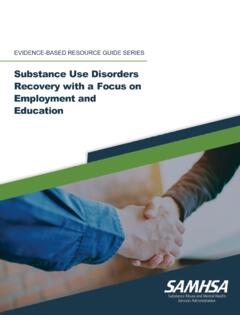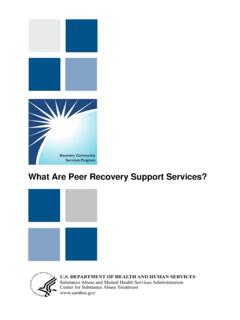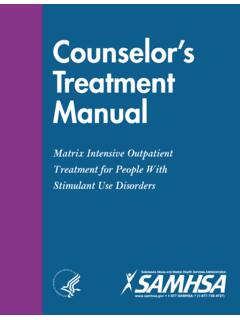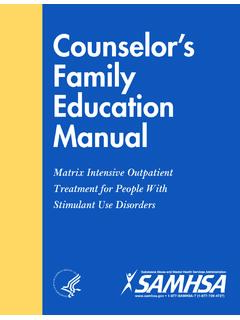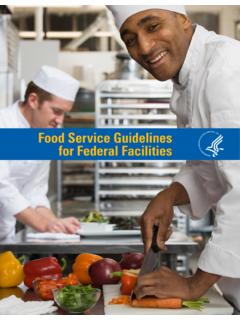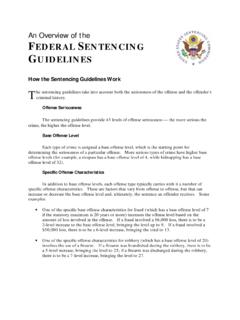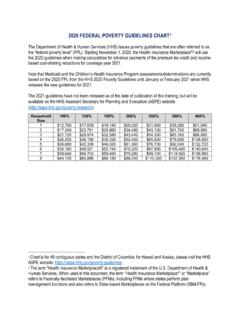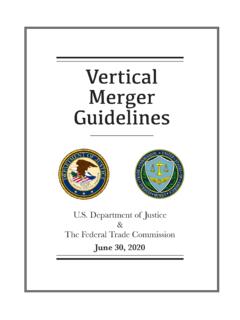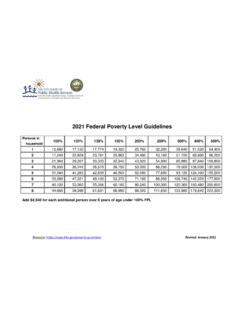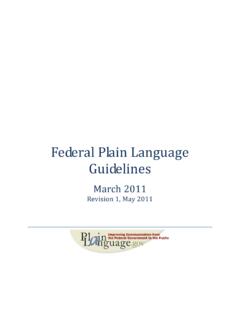Transcription of Federal Guidelines for Opioid Treatment Programs
1 0 TABLE OF CONTENTS Federal Guidelines FOR Opioid Treatment Programs January 2015 Federal Guidelines FOR Opioid Treatment Programs Acknowledgments This publication was prepared for under contract number HHSS28320070053I/HHSS28342003T by the Substance Abuse and Mental Health Services Administration (SAMHSA), Department of Health and Human Services (HHS). Nichole Washington Smith served as the Government Project Officer. Disclaimer The views, opinions, and content expressed herein are the views of the consensus panel members and do not necessarily reflect the official position of SAMHSA or HHS. No official support of or endorsement by SAMHSA or HHS for these opinions or for the instruments or resources described are intended or should be inferred. The Guidelines presented should not be considered substitutes for individualized client care and Treatment decisions. Public Domain Notice All materials appearing in this volume except those taken directly from copyrighted sources are in the public domain and may be reproduced or copied without permission from SAMHSA or the authors.
2 Citation of the source is appreciated. However, this publication may not be reproduced or distributed for a fee without the specific, written authorization of the Office of Communications, SAMHSA, HHS. Electronic Access and Copies of Publication This publication may be ordered or downloaded from SAMHSA s Publications Ordering Webpage at Or, please call SAMHSA at 1-877-SAMHSA-7 (1-877-7264727) (English). Recommended Citation Substance Abuse and Mental Health Services Administration. Federal Guidelines for Opioid Treatment Programs . HHS Publication No. (SMA) XX-XXXX. Rockville, MD: Substance Abuse and Mental Health Services Administration, 2015. Originating Office Center for Substance Abuse Treatment , Division of Pharmacologic Therapies for the Substance Abuse and Mental Health Services Administration, 1 Choke Cherry Road, Rockville, MD 20857. HHS Publication No. (SMA) PEP15-FEDGUIDEOTP First Printed 2015 TABLE OF CONTENTS 1 Federal Guidelines FOR Opioid Treatment Programs TABLE OF CONTENTS TABLE OF CONTENTS.
3 1 INTRODUCTION .. 4 Guideline Development Process .. 5 Differences between 2007 and 2015 Guidelines .. 6 Format Highlights .. 7 Federal Opioid Treatment STANDARDS .. 8 Telemedicine .. 8 Administrative Organization and Responsibilities of Individual Practitioners .. 10 Program Sponsor and Medical Director .. 10 Facility Management .. 12 Medication Unit .. 12 Human Resources Management .. 13 Risk Management .. 13 Patient and Staff Emergencies .. 13 Program Emergencies .. 14 Events that Require Immediate Response and Investigation .. 14 Continuous Quality Improvement .. 15 Community Relations and Education .. 16 Voluntary and Involuntary Program Closure .. 17 Diversion Control .. 17 Professional Staff Credentials and Development .. 20 Patient Admission Criteria .. 21 Informed Consent .. 23 Medically Supervised Withdrawal .. 24 Detoxification .. 24 Voluntary Medically Supervised Withdrawal.
4 25 Withdrawal against Medical Advice .. 26 TABLE OF CONTENTS 2 Involuntary Withdrawal from Treatment .. 26 Required Services .. 28 Initial Medical Examination Services .. 29 Pregnant and Postpartum Patients .. 30 Neonatal Abstinence Syndrome .. 32 Clinical Assessment, Treatment Planning, and Evaluation of Patient Progress in Treatment .. 33 Assessment and Treatment Planning .. 33 Evaluation .. 34 HIV and Hepatitis .. 35 Mental Health Disorders .. 36 Trauma .. 37 Tobacco Use Disorders .. 37 Alcohol Use Disorders .. 37 Benzodiazepine Use .. 38 Chronic Pain .. 38 Aftercare Planning .. 39 Recovery Oriented Systems of Care .. 39 Cultural Competency .. 40 HIV Prevention .. 41 HCV Prevention .. 41 Treatment of Adolescents .. 41 Criminal Justice Issues .. 41 Women in Treatment .. 41 Family Involvement .. 42 Alternative Therapies .. 42 Orientation to Treatment .. 42 Substance Abuse Counseling.
5 43 Twelve-Step or Other Mutual-Help Groups .. 43 Counseling for HIV, Hepatitis, and Other Infectious Diseases .. 43 Medical Services .. 43 Testing and Screening for Drug Use .. 44 Recordkeeping and Documentation .. 45 Patient Records .. 46 Records for the Storage, Dispensing, and Administration of Opioid Medication .. 48 Multiple Program Enrollment 48 Guidelines for Therapeutic Dosage and Administration .. 48 .. 49 Pharmacotherapy .. 50 General Dosage Principles .. 50 Unsupervised Approved Use (Take-Home) of Medication .. 53 TABLE OF CONTENTS 3 Medication Security .. 56 Provision of Medication to Patients Who Are Incarcerated, in Residential Treatment , Medically Compromised, or Homebound .. 56 Interim Maintenance .. 57 Exemptions .. 58 Exception Request and Record of Justification (SMA-168) Form .. 58 Exception Request for Variation from Detoxification Standards .. 59 Exception Request for Other Reasons.
6 60 Submit an SMA-168 Exception Request .. 60 APPENDIX A. REFERENCES .. 61 APPENDIX B. Guidelines PANEL .. 63 APPENDIX C. FREQUENTLY ASKED QUESTIONS .. 65 Communication with SAMHSA .. 65 Take-Home Privileges .. 69 Detoxification Programs .. 71 Treatment .. 72 Medication .. 74 Drug Testing .. 75 APPENDIX D. SAMPLES OF STANDARD FORMS .. 76 Example of Standard Consent to Opioid Maintenance Treatment .. 76 Example of Medication Chain-of-Custody Record .. 77 APPENDIX E. PROGRAM RESPONSIBILITIES .. 78 INTRODUCTION 4 Federal Guidelines FOR Opioid Treatment Programs INTRODUCTION The Federal Guidelines for Opioid Treatment Programs ( Guidelines ) describe the Substance Abuse and Mental Health Services Administration s (SAMHSA) expectation of how the Federal Opioid Treatment standards found in Title 42 of the Code of Federal Regulations Part 8 (42 CFR 8) are to be satisfied by Opioid Treatment Programs (OTPs).
7 Under these Federal regulations, OTPs are required to have current valid accreditation status, SAMHSA certification, and Drug Enforcement Administration (DEA) registration before they are able to administer or dispense Opioid drugs for the Treatment of Opioid addiction. As stated in 42 CFR (i)(2), these regulations apply to Opioid agonist Treatment medications that are approved by the Food and Drug Administration. Currently, these drugs are methadone and pharmaceutical products containing buprenorphine, hereafter referred to as buprenorphine. The regulations apply equally to both of these medications, with the only difference being the time and Treatment requirement for unsupervised dosing spelled out in 42 CFR (i)(3). Other pharmacotherapies may be provided in a manner consistent with the best medical practices for each drug. For example, the use of naltrexone has a place in OTPs but is not subject to these regulations.
8 The regulations describe a minimum acceptable standard for the operation of OTPs. They are not intended to provide clinical or medical Guidelines but rather to assure, to the greatest extent possible, the safety of both the patient and the public. Given that OTPs provide a medical service, the care delivered should be comparable to the medical care provided in other settings. These Guidelines are but one piece of what is necessary to provide comprehensive patient-centered care. They are not intended to take the place the professional judgment of healthcare providers and are not professional standards of care. SAMHSA- approved best practices for methadone can be found in the Treatment Improvement Protocol 43 (TIP 43): Medication-Assisted Treatment for Opioid Addiction in Opioid Treatment Programs ( ). For SAMHSA s best practices for the use of buprenorphine, refer to TIP 40: Clinical Guidelines for the Use of Buprenorphine in the Treatment of Opioid Addiction ( ).
9 In addition, SAMHSA partnered with the National Institute on Drug Abuse (NIDA) to provide guidance for the use of medication-assisted Treatment with extended-release injectable naltrexone for the Treatment of an Opioid use disorder. The Clinical Use of Extended-Release Injectable Naltrexone in the Treatment of Opioid Use Disorder: A Brief Guide can be accessed at This brief guide includes a summary of the key differences between extended-release injectable naltrexone, methadone, and buprenorphine. It covers key information on assessing the patient s need for Treatment , initiating medication-assisted Treatment , monitoring patient progress and adjusting the Treatment plan, and deciding whether and when to end medication-assisted Treatment . Although the Federal regulations have not changed since their original adoption in 2001, the real-world issues of Opioid use disorders, the delivery of healthcare, and the problems impacting the INTRODUCTION 5 Federal Guidelines FOR Opioid Treatment Programs health of the public change continuously.
10 By updating the Guidelines periodically, SAMHSA is not reinterpreting the regulations, but rather is expressing how these regulations may be applied in the context of clinical and medical issues confronted by OTPs today. Compliance with the regulations is assessed by SAMHSA-approved and -monitored accrediting organizations. The determination of compliance is made by these accrediting organizations based on the Guidelines put forth in this document and informed by the recognized best-practices of medicine and healthcare delivery. While these Guidelines address only 42 CFR , all of 42 CFR 8 contains information of interest to OTPs. In some cases, it is necessary to be aware of regulations from other titles or parts of the Code of Federal Regulations in order to understand the intent of 42 CFR These other regulations are cited in this document where needed. SAMHSA encourages persons interested in OTP operation to familiarize themselves with all of 42 CFR 8 by accessing GUIDELINE DEVELOPMENT PROCESS Between 1996 and 1999, SAMHSA followed a Treatment Improvement Protocol-type process and developed Federal Guidelines to assist accreditation organizations with developing standards in conformance with those set forth in 42 CFR This process included convening two expert panels to provide input into what the Guidelines should cover, conducting field reviews, and obtaining clearances from other Federal agencies and the Office of Management and Budget.
